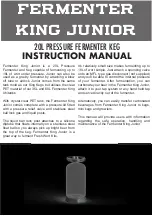
9
IT
EN
DE
5
- The crane allows the following
operating slopes:
- Machine stabilized
+/- 1 ° in the longitudinal and
transverse direction.
- Machine on tyres
+/- 2 ° in the longitudinal direction
+/- 1 ° in the transverse direction.
- If the rope on the block tends to get
twisted, unhook the fixed socket hook,
pull the rope and turn it in the opposite
direction to untwist it, then rehook the
socket.
- Raise the control lever gently to pre-
vent jerking the load and eventual
defective winding of the rope on the
drum.
- Lift the load vertically, avoiding oscilla-
tions and oblique lifting.
- Check the condition of the rope daily
and if worn or damaged or even if just
one of the threads is frayed, (see ISO
4309), replace it immediately (consult
your dealer).
- Check the working of the hook
ascent/descent hydraulic limit stops and
the brake daily, with the load applied.
- Take special care with the accessories
used for lifting the load: check the capa-
city in relation to the maximum crane
capacity and check it periodically to
make sure it is intact.
- Lubricate the rotary part of the hook
periodically with oil.
- Check the rope periodically to make
sure it is wound properly on the drum.
- The following accessories are not
meant for systems used for lifting and
transporting people.
- Before starting with the use of the
winch, or any other equipment used for
hanging the load from a hook, inform
the authorities responsible for inspection
(ISPEL) in your area (for Italy only).
- Remember to have an inspection by
the Health Authorities in your area (for
Italy only) every year.
Before commissioning the crane, check
the compatibility of the machine and the
calibration of its safety system with the
type of accessory mounted.
Non conforming calibration of the safety
system can be very dangerous for your
safety; if in doubt, do not hesitate to
contact your dealer immediately.
- Der Kran gestattet die folgenden
Arbeitsneigungen:
- Maschine stabilisiert
+/- 1 ° in der Längs- und der
Querrichtung
- Maschine auf Reifen
+/- 2 ° in der Längsrichtung
+/- 1 ° in der Querrichtung
- Wenn das Seil dazu tendiert, sich auf
der Umlenkrolle zu verdrehen, den
Haken des festen Kabelschuhs
aushaken, das Seil ziehen und in der
entgegengesetzten Richtung drehen, bis
die Verdrehung aufgehoben ist. Den
Kabelschuh dann wieder einhaken.
- Den Schalthebel vorsichtig betätigen,
um ein Springen der Last und das
etwaige falsche Aufwickeln des Seils auf
der Trommel zu vermeiden.
- Die Last vertikal heben, Oszillationen
und schräge Hebevorgänge vermeiden.
- Den Zustand des Seils täglich prüfen.
Wenn es verschlissen, beschädigt oder
auch nur ein Faden gerissen ist (siehe
ISO 4309), muss es sofort ersetzt wer-
den (siehe Vertragshändler).
- Die Funktionstüchtigkeit des hydrauli-
schen Endschalters, das Heben und
Senken des Kranhakens und den Halt
der Bremse mit angelegter Last täglich
prüfen.
- Auf die zum Heben der Last verwende-
ten Zubehörteile achten: Insbesondere
das Tragvermögen im Hinblick auf die
max. Tragfähigkeit des Krans prüfen
und täglich die Unversehrtheit kontrollie-
ren.
- Den sich drehenden Teil des
Kranhakens regelmäßig schmieren.
- Regelmäßig prüfen, dass das Seil sich
gut um die Trommel aufwickelt.
- Die folgenden Zuhörteile sind nicht für
Anlagen zum Heben und Befördern von
Personen bestimmt.
- Vor der ersten Inbetriebnahme der
Winde oder jeder anderen Ausrüstung,
bei der die Last mit einem Kranhaken
aufgehängt wird, muss diese der
zuständigen Kontrollbehörde (ISPEL)
Ihrer Gegend (gilt nur für Italien) gemel-
det werden.
- Nicht vergessen, jedes anschließende
Jahr die Inspektion bei der
Gesundheitsbehörde Ihrer Gegend zu
beantragen (gilt nur für Italien).
Vor der ersten Inbetriebnahme des
Krans die Kompatibilität der Maschinen
und die Eichung ihres
Sicherheitssystems mit dem montierten
Gerätetyp prüfen.
Eine Eichung, die nicht dem
Sicherheitssystem entspricht, kann für
Ihre Sicherheit sehr gefährlich werden.
Wenn Sie Zweifel haben, zögern Sie
nicht, sich sofort an den Vertragshändler
zu wenden.
- La gru ammette queste inclinazioni
di lavoro:
- Macchina stabilizzata
+/- 1 ° in senso longitudinale e
trasversale.
- Macchina su gomme
+/- 2 ° in senso longitudinale
+/- 1 ° in senso trasversale.
- Se la fune , sul bozzello tende ad
avvitarsi, sganciare il gancio capocor
da fisso, tirare la fune e ruotarla nel
senso opposto fino ad annullare
l’avvitamento, quindi riagganciare il
capocorda.
- Manovrare con dolcezza la leva di
comando per evitare sobbalzi del
carico ed eventuali difettosi
avvolgimenti della fune sul tamburo.
- Sollevare il carico verticalmente,
evitando oscillazioni e sollevamenti
obliqui.
- Verificare giornalmente lo stato della
fune, se usurata, rovinata o anche
solamente con un filo rotto (vedi ISO
4309), provvedere immediatamente
alla sostituzione (consultare il vostro
consessionario).
- Verificare giornalmente l’efficenza del
fine corsa idraulico salita e discesa
gancio e la tenuta del freno con carico
applicato.
- Prestare attenzione agli accessori
usati per sollevare il carico: in
particolare controllare la capacità in
relazione alla portata massima della
gru e verificarne periodicamente
l’integrità.
- Lubrificare periodicamente con olio la
parte rotante del gancio.
- Verificare periodicamente il buon
avvolgimento della fune sul tamburo.
- Gli accessori seguenti non sono
destinati ad impianti per il
sollevamento o lo spostamento di
persone.
- Prima della prima messa in servizio
dell’argano, o di qualsiasi altra
attrezzatura che appenda il carico con
un gancio, denunciarlo alla autorità
preposta per il controllo (ISPEL) della
vostra zona (solo per Italia).
- Ricordarsi ogni anno seguente di
richiedere la visita di controllo alla USL
della vostra zona (solo per Italia).
Prima della messa in servizio della gru
accertarsi della compatibilità della
macchina e della taratura del suo
sistema di sicurezza al tipo di
accessorio montato.
Una taratura non conforme del sistema
di sicurezza può risultare molto pericolo-
sa per la vostra sicurezza, se avete
dubbi non esitate, consultate immediata-
mente il vostro concessionario.
MRT 1850 - 2150 - 2540












































